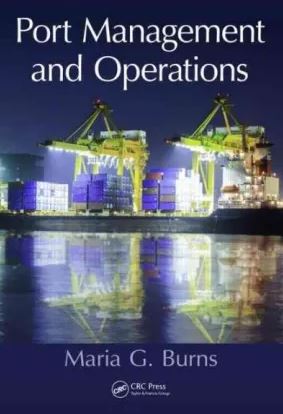Port Management and Operations 1st Edition by Maria G. Burns, ISBN-13: 978-1482206753
[PDF eBook eTextbook]
- Publisher: CRC Press; 1st edition (July 14, 2014)
- Language: English
- 408 pages
- ISBN-10: 1482206757
- ISBN-13: 978-1482206753
With 80 percent of the world’s commodities being transported by water, ports are the pillars of the global economy. Port Management and Operations offers readers the opportunity to enhance their strategic thinking and problem-solving skills, while developing market foresight. It examines global port management practices at the regulatory, commercial, technological, operational, financial, and sociopolitical levels.
This powerful sourcebook describes how seaports are being affected by the changes occurring nationally, regionally, and globally. Evaluating the new regulatory framework, it pinpoints the industry’s implementation readiness and identifies potential problem areas. The book classifies the spectrum of interrelated port management principles, strategies, and activities in a logical sequence and under four cornerstones―Port Strategy and Structure, Legal and Regulatory Framework, Input: Factors of Production, and Output and Economic Framework.
Detailing best practices and the latest industry developments, the book highlights emerging challenges for port managers and identifies opportunities to develop forward-thinking strategies. It examines the effectiveness of current strategies, tactics, tools, and resources of numerous global ports and highlights the necessity of adopting a proactive stance in harmonizing the laws, regulations, and policies pertaining to the maritime, oil, and gas industries.
The shipping industry has myriad complexities and this book provides maritime managers and professionals with the wide-ranging and up-to-date understanding required to thrive in today’s highly competitive and evolving environment.
Table of Contents:
Introduction
Port Management and Operations: Strategy in the Throes of a Transition
Port Authorities, Departments and Activities
Ports’ Strategy in the Throes of a Transition
The History of Ports: Advanced Thinking, Planning, and Development
Ports’ History and Etymology: A Passage, a Journey, and a Haven
Advanced Thinking: National Ports, Diplomacy, and Economy
Ports’ History, Planning, and Development
Port Ownership, Structure, and Organization
Forms of Port Ownership, Structure, and Organization
Port Governance
Port Ownership and Structural Types
Port Privatization
Port Workforce: Productivity, Growth, and Empowerment Strategies
Measuring Productivity, Throughput, and Growth
The Econometrics of Labor and Production
Port Growth, Productivity, and Empowerment
References
Connecting Hub Port Gateways to the Inland Infrastructure
Logistics Integration of Port Activities
The Five Stages of Integration for the Maritime Industry
Strategic Location and Market Accessibility for Existing and Emerging Seaports
Ports’ Success Factors
Supply Chain Opportunities, Competition, and Conflict Prevention
References
Port Management and Economic Growth
Establishing a Port’s Competitive Edge in a Niche World
Comparative Advantage, Competitive Advantage, Absolute Advantage and Niche: Better, the Best or Simply Different?
Economic Growth as the Space between Stimulus and Response
Physical versus Strategic Growth
Trade, Protectionism, and Free Trade
Risk Assessment (RA) and Risk Management (RM): How Far Can We Go?
The Risk Assessment Methodologies
Risk and Business Longevity
References
Port Operations
Port Management Services: Terminal Operators; Property Leasing Opportunities
Port Management Services and Operations
The Harbormaster’s Department and Functions
Terminal Manager
Vessels’ Planning
The Four Stages of Port Management and Operations
Marine Terminal Operator (MTO) Agreements and Leasing Opportunities
Marine Terminal Operators and Leasing Opportunities: Case Studies
Berths, Facilities, and Equipment
Berth Performance versus Capacity
Port Operations: The Place where Capacity and Performance Meet
The Port and Charter Party Terms
Charter Party Types
Charter Party Clauses and Areas of Dispute
The Port and Charter Party Terms
Shipyards
Introduction: The Global Shipbuilding Market
The Utility of Shipbuilding
The Components of Shipbuilding
Intellectual Property Rights
The History of Shipbuilding
Reasons for Shipyards Losing Market Share
Contemporary Shipbuilding Trends
Shipbuilding and Oil Market Analysis
Global Market Analysis
Conclusions
Port Agents: Liner Services, Tramp Trade, and Offshore Support Agents
FONASBA
Agency Selection and Practices
Port Agency Responsibilities
General Agency Duties, for Tramp, Liner, and Logistics Services
Port-Related Claims and Legal Liabilities
Conflict Resolution: Arbitration versus Court of Law
Port-Related Claims and Charter Party Clause Interpretation
Port or Berth Charter Party
Nominating a “Safe Port”
When a “Safe Port” becomes “Temporarily Unsafe”
When Communication becomes a Prerequisite to Port Safety
Stevedore Damage and Bills of Lading Stipulations
Safe Port, Security, and Loss of Time
Ship’s Off-Hire, Time Lost, and Piracy Clauses
Multimodal Transportation
References
Port and Terminal Investment
Public versus Private Investment
Return on Investment and the Impact on Trade Growth
Port Subsidies and Investment: Challenges and Opportunities
Port Subsidies
Foreign Investment
References
Ships’ Size, Ports’ Size: A New Era Ahead
International Trade Agreements as Tools to Growth
The General Agreement on Tariffs and Trade
The World Trade Organization
Multiregional Partnerships
The Americas
Asia
Africa
Europe
Middle East
Ports’ Growth and the Global Trade Agreements Matrix
Ports and Ships as Derived Demand: Traffic Forecasting
Ports and the Principles of Derived Demand
Shipping, Ports, and the Ripple Effect
Optimum Size and Economies of Scale
Capacity Utilization, Capacity Management, and Capacity Planning: Ports’ Technology and Innovation
Capacity Utilization, Capacity Management, and Capacity Planning
Port Capacity and Competition
Port Technology and Innovation
References
Strategic Alliances, Market Positioning, and Differentiation
Developing Holistic Market Positioning and Differentiation
Port Strategies and the Components of Holistic Marketing
Aligning Workforce with the Port’s Brand Promise
Port Marketing Strategy and Competitive Positioning
Market Strategy
Strategic Alliances, Joint Ventures, Mergers, and Acquisitions: The Economic Patterns of Market Response
Ports’ Strategic Alliances
Ports’ Joint Ventures
Ports’ Mergers and Acquisitions (M&A)
Competition and Conflict Prevention
Port and Terminal Competition
Conflict Prevention
Establishing Long-Term Value through Customer Loyalty
Redefining Business Loyalty in the Shipping Industry
The Benefits of Practicing Loyal Marketing
Measuring Customer Loyalty
Target Markets and Competitive Positioning
References
Key Performance Indicators as Tools of Strategic Planning and Management
Strategic Planning, Development, and Management: Exceeding the Corporate Objectives
Port Pricing Strategies: Tariff Changing and Competitiveness
The Shipping Demand Paradox
Port Pricing
Pricing Systems and Price-Setting Considerations
KPIs: Measuring Financial and Operational Performance
Port Equipment and Berth Facilities: Operations, Maintenance, and Depreciation
Port Cargo Handling Equipment (CHE)
The “Port Equipment List”
IT, Logistics, and Operational Port Equipment
Depreciation Methods
Performance Management and the Human Factor
Performance Management
The Human Factor in Port Performance
Human Factor—Survey Analysis
References
Leadership and Teambuilding
Leadership and Teambuilding Compliance: STCW, the Manila Amendments
Leadership and Teamwork
Motivation
Redefining Leadership and Teamwork through Leadership Styles
Employee Motivation, Training, and Development
Leadership and Teambuilding Assessment, Drills, and Brainstorming Exercises
References
Port Authorities and Regulatory Framework
ISM: International Safety Management
ISPS: International Ship and Port Facility Security Code
OHSAS and OSHA: Occupational Safety and Health Administration
VGP: Vessel General Permit by the US Environmental Protection Agency
ISO 14001: Environmental Management System
HAZMAT: Hazardous Materials; HAZWOPER: Hazardous Waste Operations and Emergency Response
BWM: Ballast Water Management
Incident Investigation and Root Cause Analysis
Inspections, Surveys, and Audits
Global and National Regulatory Compliance for Ships
References
Ports as a Bridge to Maritime and Offshore Energy Activities
Port Operations and Offshore Drilling: When Performance Exceeds Ambition
Regulatory Harmonization among Ports, the Offshore Industry, and OSVs
OSVs: The Link between Ports and Offshore Exploration Activities
Offshore Regulations in the United States
References
The Future of Ports
Port Development Strategy: Elements of Long-Term Strategic Planning
Strategic Port Planning
Tactical Port Planning
Port Planning and the Factors of Production
Forecasting the Market
Port Management and Forecasting Areas
The Risk Element in Forecasting
Forecasting Methods and Tools
Leading the Way
References
Index
What makes us different?
• Instant Download
• Always Competitive Pricing
• 100% Privacy
• FREE Sample Available
• 24-7 LIVE Customer Support









Reviews
There are no reviews yet.